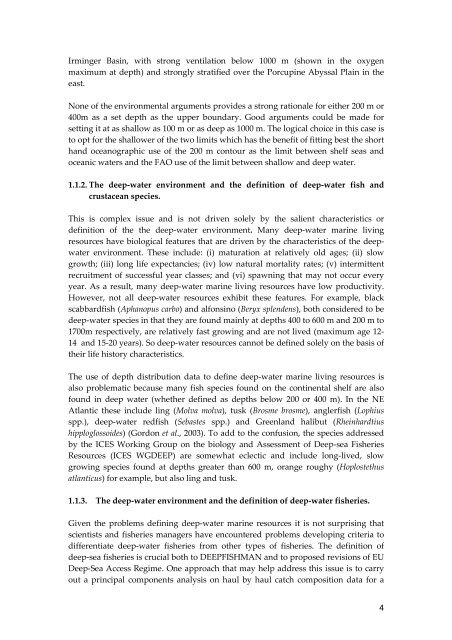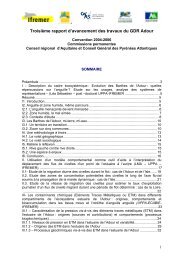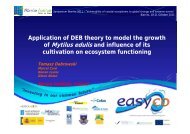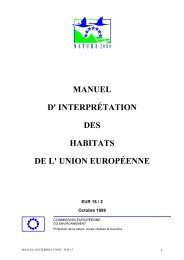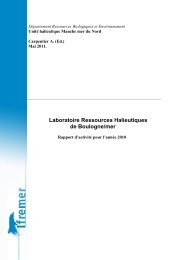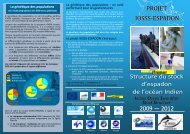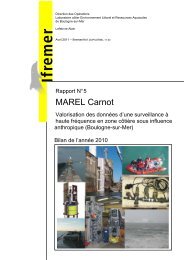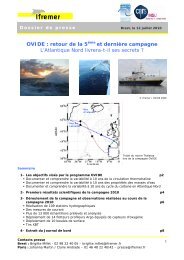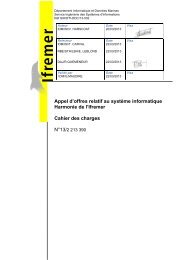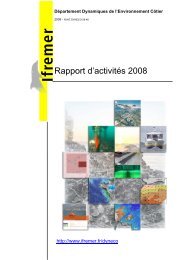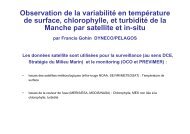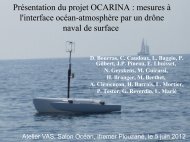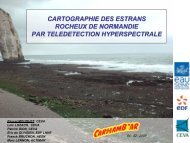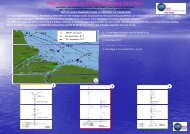DELIVERABLE D2.1 - Ifremer
DELIVERABLE D2.1 - Ifremer
DELIVERABLE D2.1 - Ifremer
You also want an ePaper? Increase the reach of your titles
YUMPU automatically turns print PDFs into web optimized ePapers that Google loves.
Irminger Basin, with strong ventilation below 1000 m (shown in the oxygenmaximum at depth) and strongly stratified over the Porcupine Abyssal Plain in theeast.None of the environmental arguments provides a strong rationale for either 200 m or400m as a set depth as the upper boundary. Good arguments could be made forsetting it at as shallow as 100 m or as deep as 1000 m. The logical choice in this case isto opt for the shallower of the two limits which has the benefit of fitting best the shorthand oceanographic use of the 200 m contour as the limit between shelf seas andoceanic waters and the FAO use of the limit between shallow and deep water.1.1.2. The deep-water environment and the definition of deep-water fish andcrustacean species.This is complex issue and is not driven solely by the salient characteristics ordefinition of the the deep-water environment. Many deep-water marine livingresources have biological features that are driven by the characteristics of the deepwaterenvironment. These include: (i) maturation at relatively old ages; (ii) slowgrowth; (iii) long life expectancies; (iv) low natural mortality rates; (v) intermittentrecruitment of successful year classes; and (vi) spawning that may not occur everyyear. As a result, many deep-water marine living resources have low productivity.However, not all deep-water resources exhibit these features. For example, blackscabbardfish (Aphanopus carbo) and alfonsino (Beryx splendens), both considered to bedeep-water species in that they are found mainly at depths 400 to 600 m and 200 m to1700m respectively, are relatively fast growing and are not lived (maximum age 12-14 and 15-20 years). So deep-water resources cannot be defined solely on the basis oftheir life history characteristics.The use of depth distribution data to define deep-water marine living resources isalso problematic because many fish species found on the continental shelf are alsofound in deep water (whether defined as depths below 200 or 400 m). In the NEAtlantic these include ling (Molva molva), tusk (Brosme brosme), anglerfish (Lophiusspp.), deep-water redfish (Sebastes spp.) and Greenland halibut (Rheinhardtiushipploglossoides) (Gordon et al., 2003). To add to the confusion, the species addressedby the ICES Working Group on the biology and Assessment of Deep-sea FisheriesResources (ICES WGDEEP) are somewhat eclectic and include long-lived, slowgrowing species found at depths greater than 600 m, orange roughy (Hoplostethusatlanticus) for example, but also ling and tusk.1.1.3. The deep-water environment and the definition of deep-water fisheries.Given the problems defining deep-water marine resources it is not surprising thatscientists and fisheries managers have encountered problems developing criteria todifferentiate deep-water fisheries from other types of fisheries. The definition ofdeep-sea fisheries is crucial both to DEEPFISHMAN and to proposed revisions of EUDeep-Sea Access Regime. One approach that may help address this issue is to carryout a principal components analysis on haul by haul catch composition data for a4


